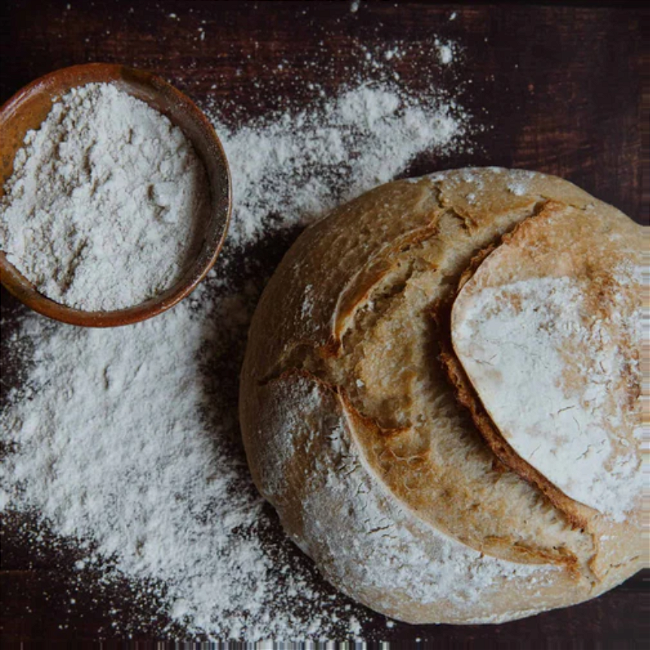Heritage Sourdough Bread Recipe
The jar we sell weighs 420g

Ingredients
-
475g Heritage White Flour or Heritage Bread Blend
-
325g Water, chlorine-free, 90F
-
1 tsp (6g) Salt
-
110g Active sourdough starter
Directions
Feed your sourdough starter 12 hours before mixing your dough- ensuring starter is bubbly and active.
Using a large mixing bowl and kitchen scale, weigh and combine flour and warm water. Mix into a shaggy dough, cover, and let rest for 30 minutes. (this is called an autolyze)
After the autolyze, add the salt to the dough and mix enough to combine it. Add the sourdough starter and mix thoroughly. Mixing can be done by hand, dough whisk, or stand mixer with dough hook attachment. Continue mixing until you have a smooth bread dough.
Cover and let rest for 30 minutes.
Stretch and Folds:
Begin the stretch and fold process by grabbing one edge of the dough and gently pulling it upward until it naturally resists stretching. Then, fold that section of dough over to the center. Next, rotate the bowl a quarter turn and repeat the process. Continue doing this two more times, so that all four sides of the dough have been stretched and folded. This completes one round of stretch and folds.
Repeat this process two more times, allowing the dough to rest for 20 minutes between each round.
After you complete your last round of stretch and folds, cover with a lid or plastic wrap and let the dough bulk ferment in a warm place until it has doubled in size. This could take anywhere from 6-12 hours (or longer) depending on a multitude of factors- have patience and don't rush the process.
Once the dough has doubled, turn it out onto a lightly floured surface.
Shaping the Dough:
Fold the dough onto itself and form into a taught little ball by cupping your hands around the dough and gently pulling it towards yourself. Your goal is to create tension on the surface of the dough.
Let the dough rest for 15 minutes uncovered. After 15 minutes, if it seems to have loosened up too much, gently re-shape it using the same process as above.
Place the dough in a floured banneton or bowl greased with olive oil, smooth side down.
Cover with plastic or place in a plastic bag and tie it shut. Place in the refrigerator for 12 hours.
Baking
Heat dutch oven to 500F for at least 30 minutes.
Remove your dough from the fridge right before you are ready to bake it.
Transfer the dough from the banneton or bowl directly onto a piece of parchment paper.
Lightly dust the dough with flour.
Score your dough with a lame or very sharp knife.
Remove hot dutch oven from the oven. Place about 4 ice cubes in your dutch oven, then add your bread dough. Be careful of the hot steam created by the ice cubes as you put your dough into the preheated dutch oven.
Place the lid back on the dutch oven, and return it to the oven. Decrease oven temp to 450F
Bake for 15 minutes. Remove cover, and bake for an additional 15-20 minutes.
At the end of the bake time check the inside temperature of bread with a thermometer. It should read 195-205F when done. If the loaf is not done or the crust isn't your desired darkness, return the loaf to the oven for a few more minutes, keeping your eye on it.
Once the loaf is done, remove from the Dutch oven and let cool on a rack.
It is important to understand that it takes practice to get the feel of sourdough baking. If you are not getting the results you desire, you can increase the amount of starter or adjust the hydration. Every time you combine flour, water, salt, and starter, it is an experiment so have fun with it.



















